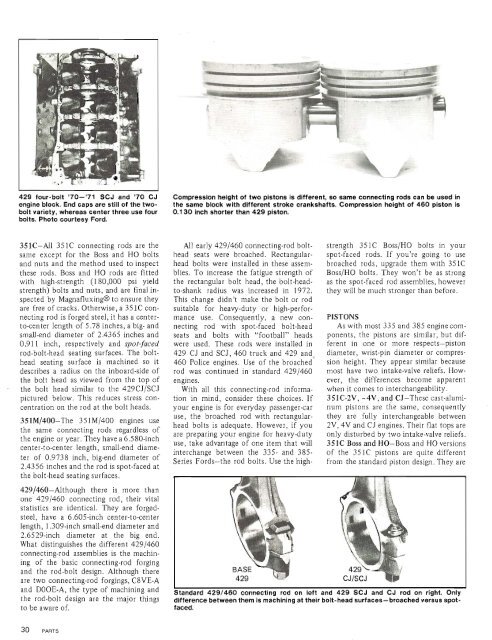How To Rebuild Your Ford V-8 351C-351M-400-429-460.pdf - Index of
How To Rebuild Your Ford V-8 351C-351M-400-429-460.pdf - Index of
How To Rebuild Your Ford V-8 351C-351M-400-429-460.pdf - Index of
Create successful ePaper yourself
Turn your PDF publications into a flip-book with our unique Google optimized e-Paper software.
<strong>429</strong> four-bolt '70-'71 SCJ and '70 CJ Compression height <strong>of</strong> two pistons is different, so same connecting rods can be used in<br />
engine block. End caps are still <strong>of</strong> the two- the same block with different stroke crankshafts. Compression height <strong>of</strong> 460 piston is<br />
bolt variety, whereas center three use four 0.130 inch shorter than <strong>429</strong> piston.<br />
bolts. Photo courtesy <strong>Ford</strong>.<br />
<strong>351C</strong>-All <strong>351C</strong> connecting rods are the<br />
same except for the Boss and HO bolts<br />
and nuts and the method used to inspect<br />
these rods. Boss and HO rods are fitted<br />
with high-strength (180,000 psi yield<br />
strength) bolts and nuts, and are final inspected<br />
by MagnafluxingB to ensure they<br />
are free <strong>of</strong> cracks. Otherwise, a <strong>351C</strong> connecting<br />
rod is forged steel, it has a centerto-center<br />
length <strong>of</strong> 5.78 inches, a big- and<br />
small-end diameter <strong>of</strong> 2.4365 inches and<br />
0.91 1 inch, respectively and spot-faced<br />
rod-bolt-head seating surfaces. The bolthead<br />
seating surface is machined so it<br />
describes a radius on the inboard-side <strong>of</strong><br />
the bolt head as viewed from the top <strong>of</strong><br />
..<br />
the bolt head similar to the <strong>429</strong>CJlSCJ<br />
pictured below. This reduces stress concentration<br />
on the rod at the bolt heads.<br />
35 1M/<strong>400</strong>-The 3 5 1 MI<strong>400</strong> engines use<br />
the same connecting rods regardless <strong>of</strong><br />
the engine or year. They have a 6.580-inch<br />
center-to-center length, small-end diameter<br />
<strong>of</strong> 0.9738 inch, big-end diameter <strong>of</strong><br />
2.4356 inches and the rod is spot-faced at<br />
the bolt-head seating surfaces.<br />
<strong>429</strong>1460-Although there is more than<br />
one <strong>429</strong>1460 connecting rod, their vital<br />
statistics are identical. They are forgedsteel,<br />
have a 6.605-inch center-to-center<br />
length, 1.309-inch small-end diameter and<br />
2.6529-inch diameter at the big end.<br />
What distinguishes the different <strong>429</strong>1460<br />
connecting-rod assemblies is the machining<br />
<strong>of</strong> the basic connecting-rod forging<br />
and the rod-bolt design. Although there<br />
are two connecting-rod forgings, C8VE-A<br />
and DOOE-A, the type <strong>of</strong> machining and<br />
the rod-bolt design are the major things<br />
to be aware <strong>of</strong>.<br />
All early <strong>429</strong>1460 connecting-rod bolthead<br />
seats were broached. Rectangularhead<br />
bolts were installed in these assemblies.<br />
<strong>To</strong> increase the fatigue strength <strong>of</strong><br />
the rectangular bolt head, the bolt-headto-shank<br />
radius was increased in 1972.<br />
This change didn't make the bolt or rod<br />
suitable for heavy-duty or high-performance<br />
use. Consequently, a new connecting<br />
rod with spot-faced bolt-head<br />
seats and bolts with "football" heads<br />
were used. These rods were installed in<br />
<strong>429</strong> CJ and SCJ, 460 truck and <strong>429</strong> and<br />
460 Police engines. Use <strong>of</strong> the broachedrod<br />
was continued in standard <strong>429</strong>1460<br />
engines.<br />
With all this connecting-rod information<br />
in mind, consider these choices. If<br />
your engine is for everyday passenger-car<br />
use, the broached rod with rectangularhead<br />
bolts is adequate. <strong>How</strong>ever, if you<br />
are preparing your engine for heavy-duty<br />
use, take advantage <strong>of</strong> one item that will<br />
interchange between the 335- and 385-<br />
Series <strong>Ford</strong>s-the rod bolts. Use the high-<br />
strength <strong>351C</strong> Boss/HO bolts in your<br />
spot-faced rods. If you're going to use<br />
broached rods, upgrade them with 35 1C<br />
BosslHO bolts. They won't be as strong<br />
as the spot-faced rod assemblies, however<br />
they will be much stronger than before.<br />
PISTONS<br />
As with most 335 and 385 engine components,<br />
the pistons are similar, but different<br />
in one or more respects-piston<br />
diameter, wrist-pin diameter or compression<br />
height. They appear similar because<br />
most have two intake-valve reliefs. <strong>How</strong>ever,<br />
the differences become apparent<br />
when it comes to interchangeability.<br />
<strong>351C</strong>-2V, -4V, and CJ-These cast-aluminum<br />
pistons are the same, consequently<br />
they are fully interchangeable between<br />
2V, 4V and CJ engines. Their flat tops are<br />
only disturbed by two intake-valve reliefs.<br />
35 1C Boss and HO-Boss and HO versions<br />
<strong>of</strong> the <strong>351C</strong> pistons are quite different<br />
from the standard piston design. They are<br />
I<br />
I<br />
Standard <strong>429</strong>/460 connecting rod on left and <strong>429</strong> SCJ and CJ rod on right. Only<br />
difference between them is machining at their bolt-head surfaces- broached versus spotfaced.
















